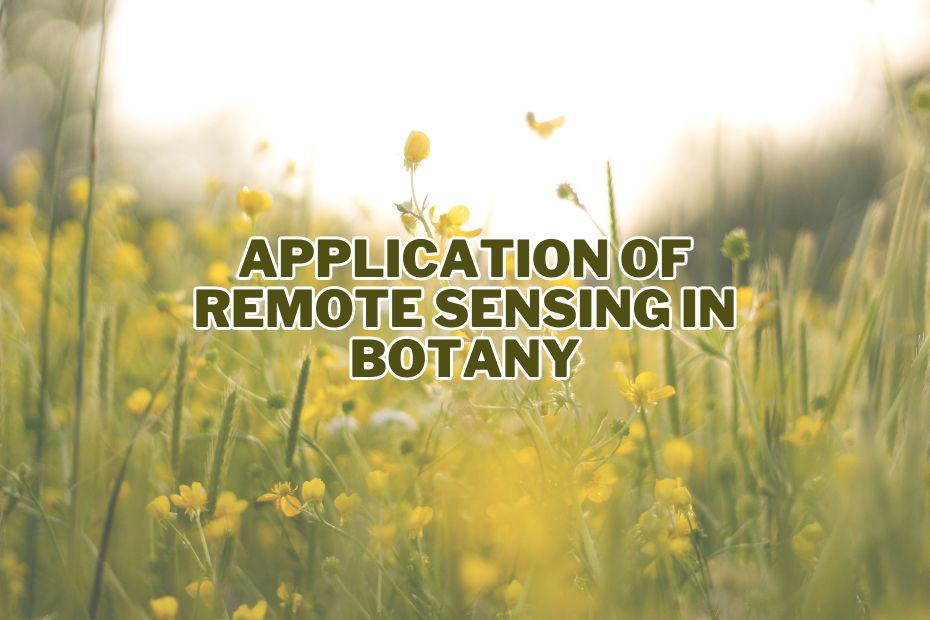Botany, the scientific study of plants, has long been a field dependent on meticulous observation and data collection. However, in recent years, the application of remote sensing technology has ushered in a new era for botanists. This powerful tool allows researchers to gather data and insights on plant life in ways previously unimaginable. In this article, we delve into the myriad application of remote sensing in botany, uncovering how it is transforming our understanding of plant ecosystems and aiding conservation efforts.
Remote sensing in botany refers to the use of satellite and aerial technology to gather data on plant ecosystems. It aids in mapping biodiversity, assessing vegetation health, monitoring forests, and studying climate change’s impact on plant life. This technology plays a vital role in conservation efforts, providing invaluable insights for botanists and researchers.
Application of Remote Sensing In Botany
Remote sensing, in the context of botany, refers to the collection of data from a distance using sensors mounted on various platforms, such as satellites, drones, and aircraft. This technology has opened up a world of possibilities in understanding plant life and ecosystems.
1. Mapping Biodiversity
Remote sensing in botany plays a pivotal role in mapping biodiversity. By using specialized sensors mounted on satellites and aircraft, researchers can capture high-resolution images of ecosystems from above. These images provide valuable data on the distribution of plant species and their health. Satellite imagery helps scientists create maps that depict the spatial distribution of different plant species, aiding in the identification of hotspots of biodiversity. This information is invaluable for conservationists working to protect endangered plant species and their habitats.
2. Assessing Vegetation Health
Understanding the health of vegetation is fundamental to botany. Remote sensing technology allows botanists to assess vegetation health on a large scale. By analyzing spectral data collected from remote sensors, scientists can determine the overall condition of plants. For instance, the Normalized Difference Vegetation Index (NDVI) measures the amount of green biomass in an area. This data helps in identifying stressed or unhealthy vegetation, which can be indicative of factors such as drought, disease, or pollution.
Incorporate this link to learn more about remote sensing applications in ecology.
3. Monitoring Forests
Forests are crucial for biodiversity, carbon sequestration, and climate regulation. Remote sensing plays a pivotal role in monitoring these vital ecosystems. It enables the continuous assessment of forest cover, deforestation rates, and even the health of individual trees. Satellite and aerial imagery can detect changes in forest cover over time, making it an invaluable tool for conservationists and forest managers.
For a deeper understanding of remote sensing in forest management, click here.
4. Crop Health Assessment
In agriculture and botany, remote sensing is used to assess the health of crops. By analyzing the spectral reflectance of crop fields, researchers can detect early signs of stress, disease, or nutrient deficiencies. This information empowers farmers to take timely actions to protect their crops and maximize yields.
5. Phenology Studies
Phenology, the study of seasonal biological events, is crucial for understanding plant life cycles. Remote sensing technology aids in tracking these events on a large scale. By analyzing satellite imagery, researchers can monitor the timing of leaf emergence, flowering, and fruiting in plant populations. This data contributes to our understanding of how climate change is affecting plant phenology.
6. Invasive Species Detection
Invasive plant species can wreak havoc on ecosystems by outcompeting native plants. Remote sensing helps identify these invaders early on. By analyzing vegetation patterns and changes in plant cover, scientists can detect the presence of invasive species and take measures to control their spread.
7. Wetland Mapping
Wetlands are unique ecosystems with high biodiversity. Remote sensing assists in mapping and monitoring wetlands, which is crucial for conservation and restoration efforts. It enables scientists to assess changes in water levels, vegetation cover, and the overall health of wetland ecosystems.
8. Climate Change Research
Botanists are at the forefront of climate change research, and remote sensing is an invaluable tool in this endeavor. It allows scientists to monitor changes in vegetation patterns, track shifts in plant distributions, and study the impact of climate change on plant ecosystems. This data is crucial for predicting and mitigating the effects of climate change on plant life.
9. Conservation Efforts
The conservation of plant species and ecosystems is a global priority. Remote sensing provides essential data for conservation efforts. It helps identify areas of high biodiversity, monitor the health of endangered plant species, and assess the effectiveness of conservation measures.
Conclusion:
In conclusion, remote sensing has revolutionized the field of botany. It empowers researchers to gather large-scale data on plant ecosystems, aiding in biodiversity conservation, vegetation health assessment, and climate change research. As technology continues to advance, the applications of remote sensing in botany are likely to expand, further enhancing our understanding of plant life and our ability to protect it.
FAQs: Application of Remote Sensing In Botany
How does remote sensing assist in biodiversity mapping?
Remote sensing assists in biodiversity mapping by providing high-resolution images of ecosystems from above. These images help researchers create maps that show the distribution of plant species, aiding in the identification of biodiversity hotspots.
What is the Normalized Difference Vegetation Index (NDVI) used for?
NDVI is a key remote sensing tool used to assess the health of vegetation. It measures the amount of green biomass in an area and can detect stressed or unhealthy plants, providing insights into factors like drought or disease.
What role does remote sensing play in conservation efforts for plant species?
Remote sensing is crucial for conservation efforts in botany. It helps identify areas with high biodiversity, monitor endangered plant species, and assess the effectiveness of conservation measures.
